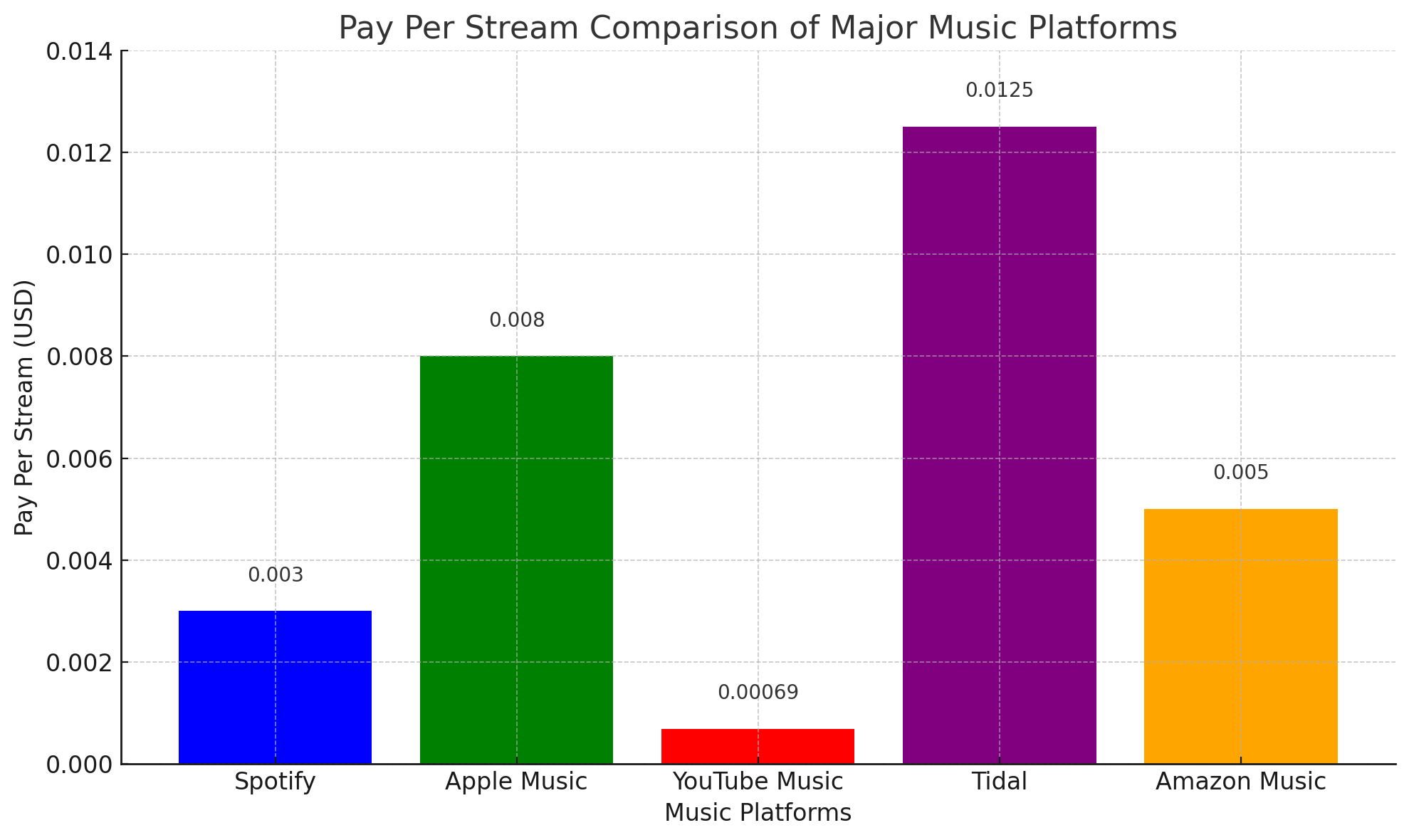The digital age has transformed the music industry, with streaming services becoming the primary way people consume music. Major platforms like Spotify, Apple Music, YouTube Music, Tidal, and Amazon Music each have unique payment models and offer distinct advantages and disadvantages for artists. This list compares and contrasts the 5 most popular platforms based on their pay-per-stream models and the benefits and drawbacks they each present.
Each streaming platform offers unique advantages and disadvantages for artists, primarily influenced by payout structures, user base size, and additional features. While Spotify and Apple Music dominate in user numbers, Tidal provides the highest per-stream payouts (your mileage may vary). YouTube Music offers vast reach but at the cost of the lowest per-stream earnings, whereas Amazon Music balances between decent payouts and growing user engagement.
Artists need to consider their priorities, such as maximizing reach, earnings, or leveraging specific platform features, to choose the best streaming service(s) for their music distribution. As always, your experience may differ but this list provides a solid overview of each of the platform’s payouts:
Spotify
Pay Per Stream:
- Average pay per stream: $0.003 to $0.005
Advantages:
- Large User Base: With over 365 million active users, Spotify offers artists extensive exposure.
- Discoverability: Features like personalized playlists and algorithmic recommendations help new artists get discovered.
- Integration: Spotify for Artists provides valuable analytics and promotional tools.
Disadvantages:
- Lower Payouts: Compared to some other platforms, Spotify’s per-stream payout is relatively low.
- Revenue Distribution: Payments are distributed based on total streams, favoring top artists and often resulting in lower earnings for lesser-known musicians.
Apple Music
Pay Per Stream:
- Average pay per stream: $0.006 to $0.01
Advantages:
- Higher Payouts: Apple Music generally offers higher per-stream payouts than Spotify.
- Integration with Apple Ecosystem: Seamless integration with Apple’s hardware and services can enhance user experience and engagement.
Disadvantages:
- Smaller User Base: With around 60 million subscribers, Apple Music has a smaller user base compared to Spotify.
- Discoverability: While Apple Music has curated playlists, it lacks the robust recommendation algorithms found on Spotify.
YouTube Music
Pay Per Stream:
- Average pay per stream: $0.00069
Advantages:
- Massive Reach: YouTube Music benefits from YouTube’s vast user base, providing substantial exposure.
- Video Integration: Artists can leverage music videos and other visual content to engage fans and earn additional revenue.
Disadvantages:
- Lowest Payouts: YouTube Music offers some of the lowest per-stream payouts in the industry.
- Ad Revenue Dependency: A significant portion of earnings comes from ad revenue, which can fluctuate.
Tidal
Pay Per Stream:
- Average pay per stream: $0.0125
Advantages:
- Highest Payouts: Tidal boasts the highest per-stream payouts among major platforms.
- Artist-Centric Model: Tidal is known for its commitment to fair compensation and high-quality audio streaming.
Disadvantages:
- Niche Market: With a smaller, niche audience, Tidal’s reach is limited compared to Spotify and Apple Music.
- High Subscription Cost: Tidal’s higher subscription fees may deter some potential users.
Amazon Music
Pay Per Stream:
- Average pay per stream: $0.004 to $0.007
Advantages:
- Integration with Amazon: Leveraging Amazon’s ecosystem, including smart speakers and Prime services, can enhance accessibility and engagement.
- Growing User Base: Amazon Music has been steadily growing, offering increasing opportunities for exposure.
Disadvantages:
- Mid-Tier Payouts: While better than YouTube Music, Amazon Music’s payouts are still not the highest.
- Competition: Competing with other Amazon services can dilute focus and attention on the music platform.

